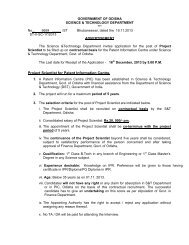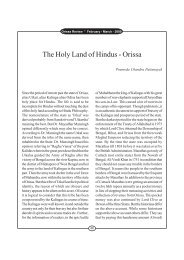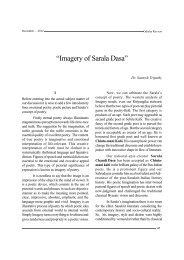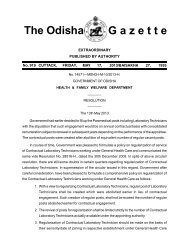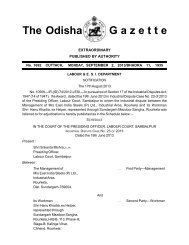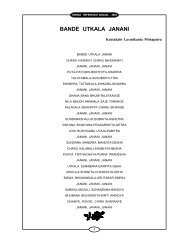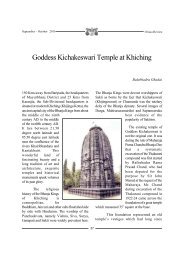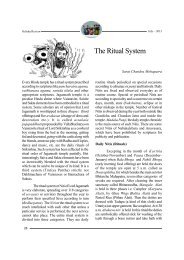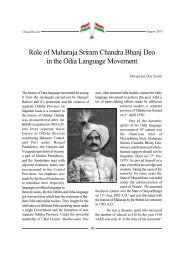Sri Krsna-jagannath Consciousness:Vyasa-jayadeva-sarala Dasa
Sri Krsna-jagannath Consciousness:Vyasa-jayadeva-sarala Dasa
Sri Krsna-jagannath Consciousness:Vyasa-jayadeva-sarala Dasa
You also want an ePaper? Increase the reach of your titles
YUMPU automatically turns print PDFs into web optimized ePapers that Google loves.
Orissa Review July - 2008<br />
<strong>Sri</strong> <strong>Krsna</strong> - Jagannath<br />
<strong>Consciousness</strong> : <strong>Vyasa</strong> -<br />
Jayadeva - Sarala <strong>Dasa</strong><br />
Dr. Satyabrata Das<br />
<strong>Vyasa</strong>'s original Sanskrit Mahabharata, his<br />
magnum opus, was written between 3rd and 4th<br />
Century B.C. The entire casting of this great<br />
Indian epic was done with a lot of care and<br />
craftsmanship. Among the dramatic personae <strong>Sri</strong><br />
<strong>Krsna</strong> seems to have received the best attention<br />
and artistic favour from the master, <strong>Vyasa</strong>dev.<br />
As it turns out, <strong>Sri</strong> <strong>Krsna</strong> emerges as the most<br />
glamorous, charismatic and the most sought-after<br />
character. He is not only the possessor of the<br />
unique panchajanya conch and the formidable<br />
Sudarshan Chakra; he is the omniscient,<br />
philosopher-king, rhetorician, diplomat, strategist,<br />
statesman, guide, friend, preceptor, consciencekeeper,<br />
crisis-manager, spokesperson and the<br />
ambassador of the Pandavas.<br />
Further, <strong>Vyasa</strong>'s doting on the character<br />
of <strong>Sri</strong> <strong>Krsna</strong> takes the centre-stage and remains<br />
the focal-point in the entire stretch of the<br />
grandiloquent Shrimad Bhagavad Gita, a massive<br />
sub-plot, that spans quite impressive eighteen<br />
chapters, and ultimately turns out to be the<br />
quintessence of the great epic.<br />
On this ionian highway the next<br />
conspicuous milestone after <strong>Vyasa</strong> that we<br />
stumble upon is the 12th century Sanskrit poet<br />
from Orissa, Jayadeva. While <strong>Vyasa</strong> only<br />
highlights <strong>Krsna</strong>'s spiritual, intellectual and<br />
diplomatic traits and blows the character out into<br />
a larger - than - life stature; Jayadeva in his classic<br />
Gita Govinda focuses only on the sensuous,<br />
romantic inter-actions between the divine pair, <strong>Sri</strong><br />
<strong>Krsna</strong> and <strong>Sri</strong> Radha, often bordering on<br />
sensuality and licentiousness. Jayadeva conceives<br />
the characters of <strong>Sri</strong> <strong>Krsna</strong> and <strong>Sri</strong> Radha as<br />
divine companions though, all along the classic<br />
Gita Govinda we have the feeling that the poet<br />
delicately and immaculately brings out the finer<br />
and the most elemental virtues like love, longing,<br />
ecstasy and transcendence without any conscious<br />
attempt to mystify or to portray them out into<br />
larger-than-life statures. The poet with the best<br />
of his artistic and lyrical manoeuvres keeps himself<br />
grounded in reality.<br />
More than three hundred years after, yet<br />
another Oriya poet, with no direct knowledge of<br />
Sanskrit or any trace of scholarship, and purely<br />
from agrarian background shows an incredible<br />
feat by composing the Mahabharata in Oriya. And<br />
thus doing he becomes the pioneer, the pathfinder.<br />
And soon others from Bengal, Assam and<br />
the Hindi belt follow the suit. He is Sarala <strong>Dasa</strong>.<br />
His Mahabharata in Oriya is not a translation of<br />
the original Sanskrit Mahabharata, nor even<br />
written in the shadow of it. It is out and out original<br />
both in structure and content though; the general<br />
schemata and the main story-line remains on the<br />
backdrop. As a western scholar John Boulton<br />
looks at it : "Sarala <strong>Dasa</strong>'s Mahabharata was the<br />
first important Oriya work on the Jagannath cult.<br />
Though <strong>Sri</strong> <strong>Krsna</strong> is portrayed as the protagonist<br />
of Sarala Mahabharata, <strong>Sri</strong> Jagannath continues<br />
to be Sarala's "counter theme".<br />
48
Orissa Review July - 2008<br />
As Boulton explains :<br />
Scattered throughout his Mahabharata,<br />
Sarala presents a number of historical, racial<br />
memories, which appear in the form of dream like,<br />
narrative sequence. In recounting them he is<br />
obviously looking back from the stand-point of a<br />
tradition It is clear from his account that his<br />
sympathies lie with the Savaras, whose God in<br />
origin Jagannath was.<br />
Sarala (who proves himself every inch a<br />
poet, original and striking) breaks away from the<br />
master craftsman <strong>Vyasa</strong> in more than one ways.<br />
First, he heavily rationalizes the portrayal of the<br />
character of <strong>Sri</strong> <strong>Krsna</strong>. In a way, Sarala reacts<br />
against the Sanskritic-Hindu-Aryan pantheon of<br />
Gods and Goddesses. So we are not at all<br />
surprised to find the various Gods and Goddesses<br />
including Lord <strong>Krsna</strong> without any supernatural<br />
clout or larger-than-life portrayal in Sarala<br />
Mahabharata. As Boulton comments:<br />
here we come to the crux of the matter - Sarala<br />
<strong>Dasa</strong> behaves towards <strong>Krsna</strong> in the traditional<br />
manner of Oriyas towards Jagannath : he mocks<br />
and debunks him. In doing so he breaks away<br />
from the path of both <strong>Vyasa</strong> and Jayadeva.<br />
<strong>Vyasa</strong> had exalted <strong>Krsna</strong> as the<br />
philosopher-hero and Jayadeva as the divine<br />
lover. But Sarala <strong>Dasa</strong> refuses to regard <strong>Krsna</strong>/<br />
Jagannath as anything but an equal, whose faults<br />
are to be mocked and censured.<br />
But all the same, Sarala, who uses the Oriya<br />
lingua franca as his medium successfully creates an<br />
atmosphere of informality in dealing with <strong>Sri</strong> <strong>Krsna</strong><br />
or <strong>Sri</strong> Jagannath that becomes the very spirit of<br />
typical Oriya devotees including the Sevayats of<br />
Puri Temple. They look upon Lord Jagannath as a<br />
member of their family - so close, so intimate, so<br />
informal. Thus the Mahabharata of Sarala <strong>Dasa</strong> is<br />
a world apart from the Mahabharata of <strong>Vyasa</strong>dev.<br />
That explains why Sarala has skipped the entire<br />
Shrimad Bhagavad Gita and heavily abridged the<br />
Santi Parva of <strong>Vyasa</strong>'s original. Nowhere do we<br />
find <strong>Vyasa</strong>'s omniscient, philosopher-king <strong>Krsna</strong><br />
in Sarala's epic.<br />
<strong>Sri</strong> Jagannath Cult : A veritable melting pot : Orissa<br />
(synonymous with <strong>Sri</strong> Jagannath - a cult, a way<br />
of life, a living culture) has been a meeting ground,<br />
a melting pot of all sects and faiths since time<br />
immemorial. Brahmanya, Jaina, Buddha, Natha,<br />
Saivya, Shakta, Soura, Ganapatya, Nirguna,<br />
Saguna, Vaishnava - all streams have flooded the<br />
Orissa coast. And Sarala Mahabharata has the<br />
unique distinction of integrating, synthesizing and<br />
reflecting the myriad thoughts and faiths. At<br />
several points in Sarala Mahabharata, Jagannath<br />
is identified as Buddha, <strong>Krsna</strong> and Rama.<br />
As Sarala writes in the Adi Parva :<br />
Salute thee <strong>Sri</strong> Jagannath<br />
The revered One whose domain<br />
Is the Blue Hills:<br />
He sits pretty as <strong>Sri</strong> Buddha<br />
There in the Blue Cavern<br />
At another point in the Adi Parva Sarala writes:<br />
Glory be to Rama <strong>Krsna</strong><br />
Brahmaa as Subhadra<br />
And to the great soul Buddha <br />
In Madhya Parva Sarala writes :<br />
There comes <strong>Sri</strong> Jagannath<br />
As Buddha to liberate the Mankind <br />
(Translation : mine)<br />
Such instances are many where Sarala looks at<br />
<strong>Sri</strong> Jagannath as one with <strong>Sri</strong> <strong>Krsna</strong>, <strong>Sri</strong> Rama,<br />
and Buddha. A wonderful integration, a rare<br />
unification and synthesis of all faiths and paths.<br />
Sarala Mahabharata indeed is a unified voice, a<br />
sum total of the consciousness that draws its<br />
energy and vibration from one common source -<br />
the <strong>Krsna</strong> - Jagannath pool<br />
Reference :<br />
Boulton, John. Essays on Oriya Literature. ed.<br />
Ganeswar Mishra. Kolkata : Profulla, 2003.<br />
Dr. Satyabrata Das is a Senior Reader and Head, Deptt.<br />
of English, Ekamra College, Bhubaneswar.<br />
49



